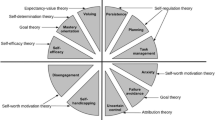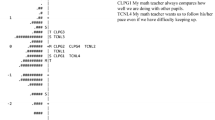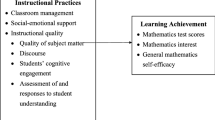Abstract
Engaging students as active participants in mathematics classroom discussions has great potential to promote student learning. Less well understood is how teachers can promote beneficial student participation, and how teacher-student interaction relates to student achievement. This study examined how the kinds of teacher practices that may encourage beneficial student participation relate to student achievement in elementary school mathematics classrooms. Using videotaped recordings, we examined the extent to which students explained their own ideas and engaged with others’ ideas and how teachers supported these kinds of student participation. Linking teacher practices, student participation, and achievement all at the individual student level, we found that student achievement was best predicted by the combination of teacher practices and student participation. The results show that taking into account student participation is necessary for understanding how teaching practices relate to student mathematics learning.

Similar content being viewed by others
Notes
Similar recommendations appear in curriculum standards in other countries, such as the Australian Association of Mathematics Teachers Standards for Excellence in Teaching Mathematics in Australian Schools (2006); Finnish National Core Curriculum for Basic Education (2012), and New Zealand Curriculum (2008).
An additional standardized mathematics achievement measure was initially considered as a posttest measure. However, the high, positive correlation between the prior achievement measure and standardized achievement measure, r(71) = .69, p < .01, indicated that none of the other variables would significantly relate to posttest achievement after partialling out the influence of prior achievement.
All analyses were run using HLM for Windows (Raudenbush, Bryk, Cheong, Congdon, & du Toit, 1996–2011). All variables in the analyses were group-mean centered (Raudenbush & Bryk, 2002); the intercept represents the average classroom outcome and the slopes represent the within-classroom relationships.
To ensure that students from a single classroom were not driving results, all regression analyses were also carried out omitting students from one classroom at a time. The point estimates changed very little, suggesting that no particular classroom of students was overly influential.
Results from ordinary least squares regression analyses that did not take into account the nested structure of the data mirrored those of the HLM analyses. For simplicity, we do not show those results here.
Following Preacher and Hayes (2008), we also calculated a bootstrap confidence interval for the indirect effect. Consistent with the results of the Sobel z test, the confidence interval did not include zero, also providing further evidence of a non-zero mediation effect.
The discussion of 0/3 lasted for 17 min where extensive exchange occurs across students, and the ideas in this exchange are further interrogated.
References
Australian Association of Mathematics Teachers, Inc. (2006). Standards for excellence in teaching mathematics in Australian schools. Adelaide, SA, Australia: Author.
Bauer, D. J., Preacher, K. J., & Gil, K. M. (2006). Conceptualizing and testing random indirect effects and moderated mediation in multilevel models: New procedures and recommendations. Psychological Methods, 11(2), 142–163.
Carpenter, T. P., Fennema, E., Franke, M. L., Empson, S. B., & Levi, L. W. (1999). Children’s mathematics: Cognitively guided instruction. Portsmouth, NH: Heinemann.
Chi, M. T. H. (2000). Self-explaining expository texts: The dual processes of generating inferences and repairing mental models. In R. Glaser (Ed.), Advances in instructional psychology: Educational design and cognitive science (pp. 161–238). Hillsdale, NJ: Erlbaum.
Finnish National Board of Education. (2012). Finnish National Core Curriculum for Basic Education. Helsinki, Finland: Author.
Franke, M. L., Kazemi, E., & Battey, D. (2007). Understanding teaching and classroom practice in mathematics. In F. K. Lester (Ed.), Second handbook of research on mathematics teaching and learning (pp. 225–256). Charlotte, NC: Information Age Publishing.
Franke, M. L., Turrou, A. C., Webb, N. M., Ing, M., Wong, J., Shin, N., & Hernandez, C. H. (in press). Teacher support of student engagement in elementary school mathematics classrooms. Elementary School Journal.
Franke, M. L., Webb, N. M., Chan, A., Ing, M., Freund, D., & Battey, D. (2009). Teacher questioning to elicit students’ mathematical thinking in elementary school classrooms. Journal of Teacher Education, 60(4), 380–392.
Gillies, R., & Boyle, M. (2008). Teachers discourse during cooperative learning and their perceptions of this pedagogical practice. Teaching and Teacher Education, 24(5), 1333–1348.
Gillies, R. M., & Haynes, M. (2011). Increasing explanatory behavior, problem-solving, and reasoning within classes using cooperative group work. Instructional Science, 39(3), 349–366.
Gillies, R. M., & Khan, A. (2009). Promoting reasoned argumentation, problem-solving and learning during small-group work. Cambridge Journal of Education, 39(1), 7–27.
Hatano, G. (1993). Time to merge Vygotskian and constructivist conceptions of knowledge acquisition. In E. A. Forman, N. Minick, & C. A. Stone (Eds.), Contexts for learning: Sociocultural dynamics in children’s development (pp. 153–166). New York: Oxford University Press.
Kazemi, E., & Stipek, D. (2001). Promoting conceptual thinking in four upper-elementary mathematics classrooms. Elementary School Journal, 102, 59–80.
MacKinnon, D. P. (2008). Introduction to statistical mediation analysis. Mahwah, NJ: Erlbaum.
National Governors Association Center for Best Practices, & Council of Chief State School Officers. (2010). Common core standards mathematics. Washington, DC: Authors.
National Research Council. (2001). Adding it up: Helping children learn mathematics. Washington, DC: National Academies Press.
New Zeland Ministry of Education. (2008). The New Zealand Curriculum. Wellington, New Zealand: Author.
O’Connor, M. C., Michaels, S., & Chapin, S. H. (2015). “Scaling down” to explore the role of talk in learning: From district intervention to controlled classroom study. In L. B. Resnick, C. Asterhan, & S. N. Clarke (Eds.), Socializing intelligence through talk and dialogue. Washington, DC: American Educational Research Association.
Perry, M. (2000). Explanations of mathematical concepts in Japanese, Chinese and the U.S. first- and fifth-grade classrooms. Cognition and Instruction, 18(2), 181–207.
Preacher, K. J., & Hayes, A. F. (2008). Asymptotic and resampling strategies for assessing and comparing indirect effects in multiple mediator models. Behavior Research Methods, 40(3), 879–891.
Raudenbush, S. W., & Bryk, A. S. (2002). Hierarchical linear models: Applications and data analysis methods (2nd ed.). Newbury Park, CA: Sage.
Raudenbush, S. W., Bryk, A. S., Cheong, Y. F., Congdon, R., & Du Toit, M. (1996–2011). HLM 7: Hierarchical linear and nonlinear modeling (Version 7) [Computer Software]. Lincolnwood, IL: Scientific Software International.
Roscoe, R. D., & Chi, M. (2008). Tutor learning: The role of instructional explaining and responding to questions. Instructional Science, 36(4), 321–350.
Sfard, A., & Kieran, C. (2001). Cognition as communication: Rethinking learning-by-talking through multi-faceted analysis of students’ mathematical interactions. Mind, Culture, and Activity, 8, 43–76.
Sfard, A., Nesher, P., Streefland, L., Cobb, P., & Mason, J. (1998). Learning mathematics through conversation: Is it as good as they say? For the Learning of Mathematics, 18, 41–51.
Shavelson, R. J., & Webb, N. M. (1991). Generalizability theory: A primer. Thousand Oaks, CA: Sage.
Sobel, M. E. (1986). Some new results on indirect effects and their standard errors in covariance structure models. In N. Tuma (Ed.), Sociological Methodology 1986 (pp. 159–186). Washington, DC: American Sociological Association.
Studiocode Business Group. (1997–2013). Studiocode (Version 4.5.1) [Computer software]. Camarillo, CA: Author.
Veenman, S., Denessen, E., van den Akker, A., & van der Rijt, J. (2005). Effects of a cooperative learning program on the elaborations of students during help seeking and help giving. American Educational Research Journal, 42, 115–151.
Walshaw, M., & Anthony, G. (2008). The role of pedagogy in classroom discourse: A review of recent research into mathematics. Review of Educational Research, 78(3), 516–551.
Warner, L. B. (2008). How do students’ behaviors relate to the growth of their mathematical ideas? Journal of Mathematical Behavior, 27(3), 206–227.
Webb, N. M., Franke, M. L., De, T., Chan, A. G., Freund, D., Shein, P., et al. (2009). Teachers’ instructional practices and small-group dialogue. Cambridge Journal of Education, 39, 49–70.
Webb, N. M., Franke, M. L., Ing, M., Chan, A., De, T., Freund, D., et al. (2008). The role of teacher instructional practices in student collaboration. Contemporary Educational Psychology, 33(3), 360–381.
Webb, N. M., Franke, M. L., Ing, M., Wong, J., Hernandez, C. H., Shin, N., et al. (2014). Engaging with others’ mathematical ideas: Interrelationships among student participation, teachers’ instructional practices and learning. International Journal of Educational Research, 63, 79–93.
Yackel, E., Cobb, P., Wood, T., Wheatley, G., & Merkel, G. (1990). The importance of social interaction in children’s construction of mathematical knowledge. In T. J. Cooney & C. R. Hirsch (Eds.), Teaching and learning mathematics in the 1990s (pp. 12–21). Reston, VA: National Council of Teachers of Mathematics.
Acknowledgments
This research was supported by a grant (#R305A100181) from the Institute of Education Sciences of the U.S. Department of Education. The views expressed in this paper are the authors’ alone and do not reflect the views or policies of the funding agency. We wish to thank Nicholas C. Johnson for his helpful comments on this article.
Author information
Authors and Affiliations
Corresponding author
Rights and permissions
About this article
Cite this article
Ing, M., Webb, N.M., Franke, M.L. et al. Student participation in elementary mathematics classrooms: the missing link between teacher practices and student achievement?. Educ Stud Math 90, 341–356 (2015). https://doi.org/10.1007/s10649-015-9625-z
Published:
Issue Date:
DOI: https://doi.org/10.1007/s10649-015-9625-z




